Best Real Estate Photography Equipment for Stunning Listings
Discover the essential real estate photography equipment you need for professional property photos. Complete guide to cameras, lenses, lighting, and editing tools.
Want to capture stunning real estate photos that attract more buyers and close deals faster? Dark, blurry, and unprofessional images hurt your listings. This listicle presents eight essential pieces of real estate photography equipment to elevate your property photography. Whether you're a seasoned agent or just starting, discover the cameras, lenses, lighting, and software—including innovative tools like Pedra—that will transform your visuals and help you stand out from the competition.
1. Pedra
While not traditional "real estate photography equipment" like a camera or lens, Pedra deserves a top spot on this list because it revolutionizes how real estate professionals use and enhance their visual assets. This AI-powered software acts as a virtual staging and photo enhancement powerhouse, transforming ordinary property photos into captivating marketing materials with just a single click. Forget expensive photoshoots and time-consuming edits – Pedra empowers agents to showcase a property's full potential quickly and efficiently, making it a valuable tool in any real estate photography arsenal. Whether you're selling off-plan developments, new builds, or existing homes, Pedra can dramatically upgrade your marketing game.
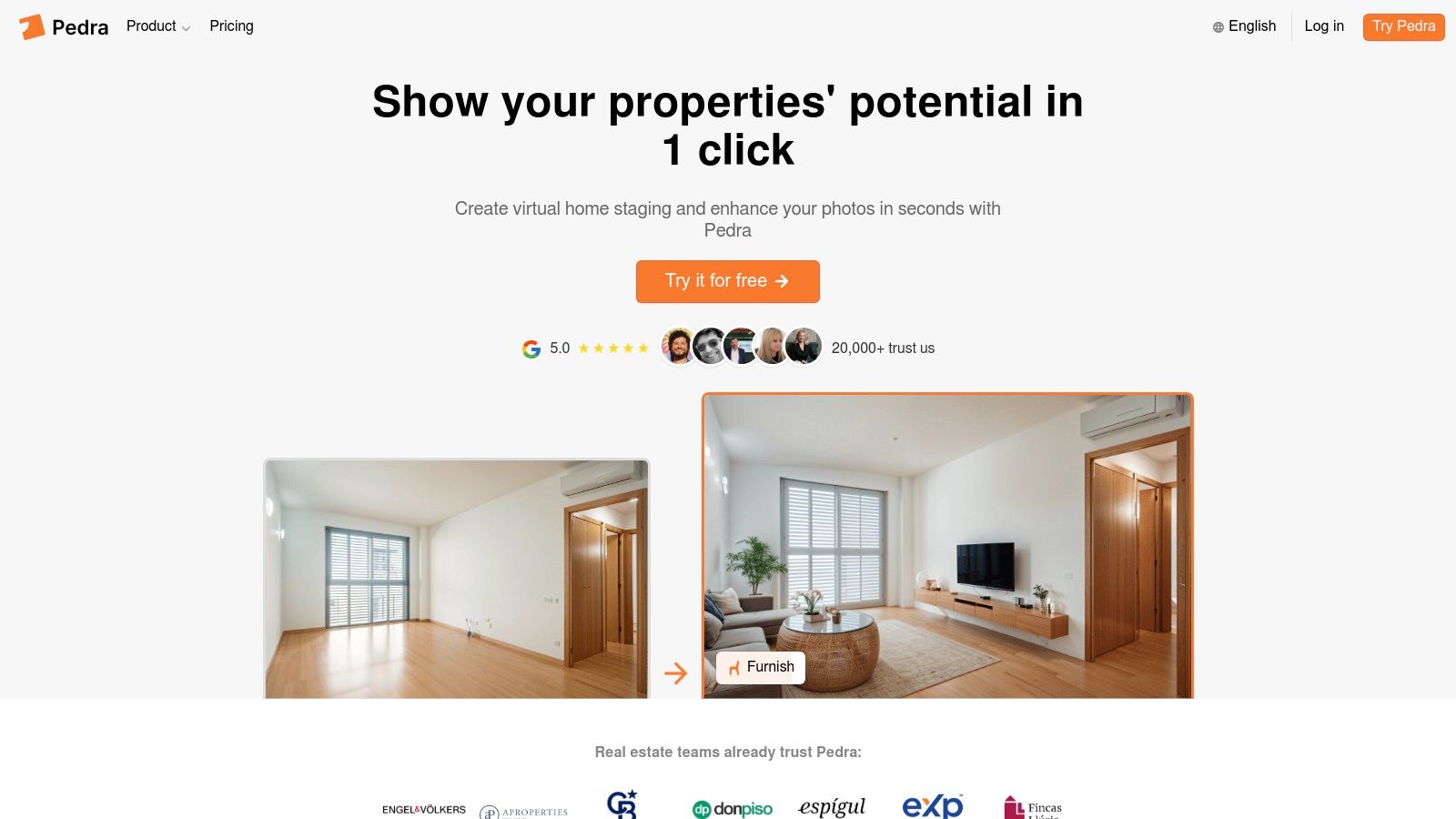
Imagine taking a photo of an empty room and, within moments, transforming it into a warmly furnished, inviting space. Pedra allows you to virtually stage rooms, declutter existing interiors, even perform virtual renovations inside and out. Need to adjust the lighting, correct a skewed perspective, or remove an unwanted watermark? Pedra handles it all. You can even replace a dull sky with a vibrant sunset, creating the perfect ambiance to attract potential buyers. Beyond static images, Pedra also generates floor plan visualizations, creates immersive property videos, and builds compelling virtual tours, offering a comprehensive suite of tools for showcasing any property in its best light.
This ease of use makes it a game-changer for real estate agents and companies of all sizes. No technical expertise is needed to navigate Pedra's intuitive interface. Its features, like one-click virtual staging and automated enhancements, streamline your workflow, saving you both time and money. With over 20,000 users and a consistent 5-star rating, Pedra's effectiveness is well-documented.
Pricing and Plans
Pedra offers a flexible subscription model starting with a Pro plan at €29/month, which includes 100 AI-generated images. Affordable add-on packs are available if you require more image generations, and pay-as-you-go options cater to occasional users. For those seeking a truly hands-off approach, Pedra also provides professional editing services.
Pros
- One-click AI-powered virtual staging and photo enhancement significantly streamlines marketing efforts.
- Wide range of features including virtual furnishing, decluttering, renovation, lighting optimization, perspective correction, watermark removal, and sky replacement.
- Supports floor plan rendering, video creation, and virtual tours for comprehensive property showcasing.
- User-friendly interface requiring no technical expertise, ideal for both individual agents and real estate companies.
- Affordable and flexible subscription plans starting at €29/month.
Cons
- The 100-image monthly limit on the Pro plan might necessitate purchasing additional credits for high-volume users.
- While incredibly user-friendly, maximizing the potential of certain advanced features might require some initial learning or training.
Implementation Tip
Start with a free trial or the basic plan to familiarize yourself with the platform. Explore the various features and experiment with different virtual staging options. Once comfortable, consider upgrading to a plan that best suits your needs and volume of work.
Website: https://pedra.so
Pedra's combination of powerful AI technology, intuitive design, and affordable pricing makes it an invaluable addition to any real estate photographer's toolkit – even if you're not a photographer at all. It empowers real estate professionals to create visually stunning marketing materials that grab attention, generate more leads, and ultimately, sell properties faster.
- Canon EOS 5D Mark IV
The Canon EOS 5D Mark IV is a workhorse in the world of professional photography, and it earns a top spot on this list of essential real estate photography equipment. This full-frame DSLR offers exceptional image quality, making it a favorite among real estate agents, realtors, real estate companies, inmobiliarias, and home staging/marketing businesses aiming to showcase properties in their best light. Its versatility and reliability are key features that contribute to its popularity in the demanding field of real estate photography.
This camera's 30.4 megapixel full-frame CMOS sensor is the star of the show. It captures incredibly detailed images with a wide dynamic range. Why is dynamic range important for real estate photography? Think bright windows and shadowy corners within the same room. A high dynamic range allows you to capture detail in both the highlights (bright areas) and the shadows (dark areas), preventing blown-out windows and overly dark interiors. This is crucial for creating balanced and appealing photos that accurately represent the property. The DIGIC 6+ image processor further enhances image quality and contributes to excellent low-light performance, perfect for capturing interior shots without excessive noise.
The 5D Mark IV boasts a robust 61-point autofocus system ensuring sharp images even in challenging lighting conditions. From capturing the intricate details of a kitchen backsplash to showcasing the spaciousness of a living room, this camera delivers consistent results. Its weather-sealed body is a bonus for real estate photographers who often find themselves shooting exteriors in varying weather conditions.
For real estate agents and realtors creating video tours, the 4K video recording capability is a valuable asset. However, be aware that the 4K video mode has a noticeable crop factor.
Features
- 30.4 megapixel full-frame CMOS sensor
- DIGIC 6+ image processor with ISO range 100-32000
- 4K video recording
- 61-point autofocus system
- Built-in Wi-Fi and GPS
Pros
- Exceptional image quality and dynamic range
- Weather-sealed body for durability
- Reliable autofocus performance
- Excellent low-light performance
Cons
- Significant investment (approximately $2,500 body only)
- Heavier than mirrorless alternatives
- 4K video has a significant crop factor
- Can have a learning curve for beginners
Implementation Tip
Pairing the Canon EOS 5D Mark IV with a wide-angle lens, such as a 16-35mm, is highly recommended for real estate photography. This allows you to capture the full scope of a room and create a sense of spaciousness.
While it's a considerable investment, the Canon EOS 5D Mark IV's outstanding image quality, reliability, and versatility justify its place among top-tier real estate photography equipment. Learn more about Canon EOS 5D Mark IV . For those seeking professional-grade results for their listings, this camera is a powerful tool. You can find more details on the official website: https://www.usa.canon.com/cameras/dslr-cameras/eos-5d-mark-iv .
3. Sony Alpha a7 III
The Sony Alpha a7 III is a popular choice among real estate photographers seeking a balance of professional features and portability. This full-frame mirrorless camera offers exceptional image quality, useful features specifically for real estate, and a compact design that makes it easy to handle on location. Its impressive dynamic range allows you to capture details in both bright highlights and dark shadows, crucial for showcasing interior spaces with window views. Whether you're a seasoned real estate agent or part of a home staging company, the a7 III provides the tools to elevate your property listings.
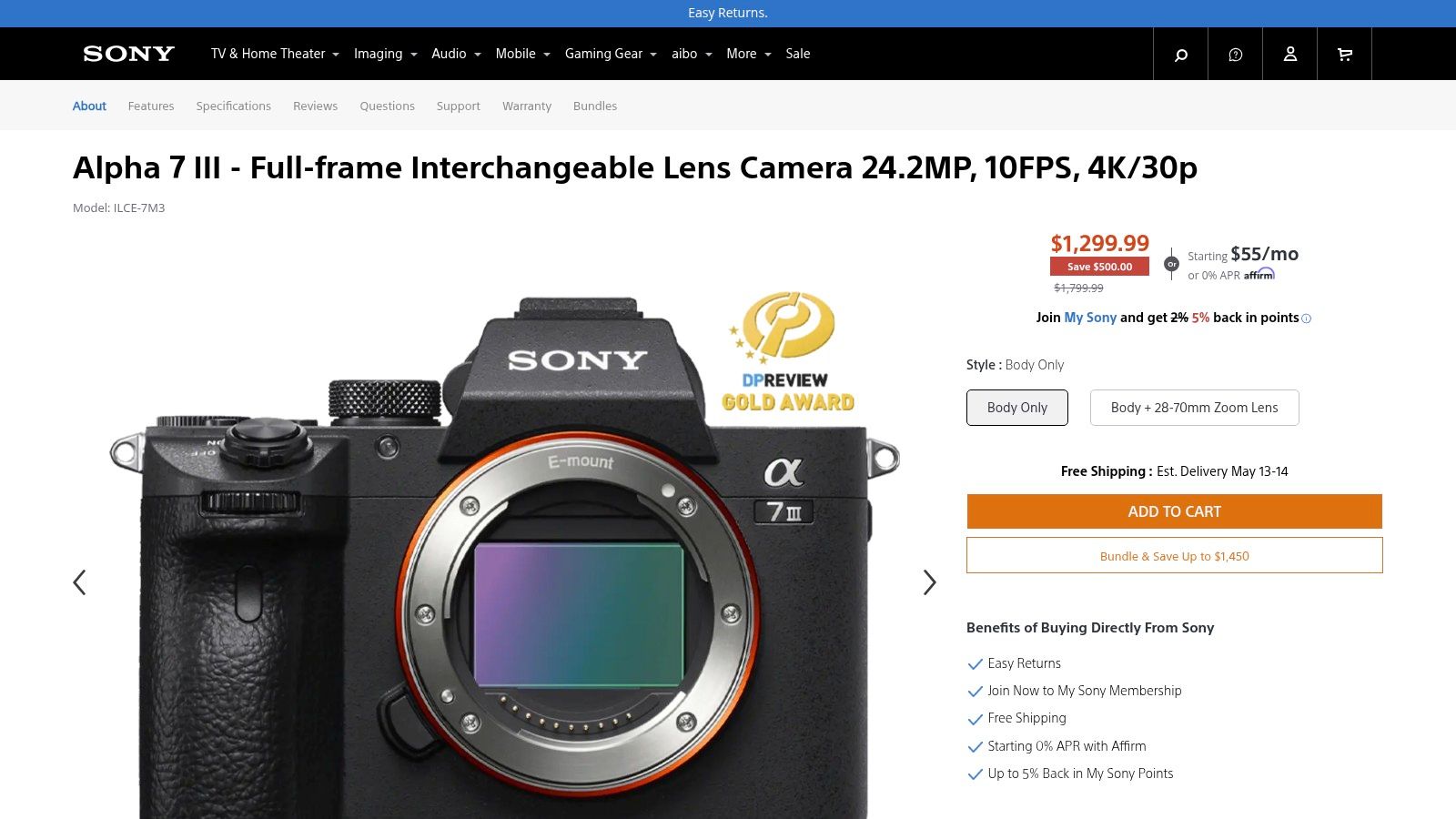
This camera's 24.2MP full-frame Exmor R CMOS sensor and BIONZ X image processing engine work together to produce high-resolution images with accurate colors and rich detail. The 5-axis in-body image stabilization is a huge advantage for real estate photography, allowing you to shoot handheld in challenging lighting conditions and still achieve sharp images. This is particularly useful when photographing interiors with limited natural light, minimizing the need for a tripod and speeding up your workflow. The 693-point hybrid autofocus system quickly and accurately locks onto subjects, ensuring crisp, clear images every time. Furthermore, its 4K HDR video capability allows you to create stunning video walkthroughs, a valuable addition for real estate marketing in today's digital landscape. For realtors and real estate companies aiming to create high-quality marketing materials, the video capabilities open up exciting possibilities.
The a7 III stands out from entry-level options due to its superior low-light performance (up to ISO 51,200). This allows you to capture clean and noise-free images even in dimly lit rooms, preserving the ambiance and highlighting key features without resorting to excessive flash photography. This is a crucial feature for real estate photography equipment, where showcasing a property in its best light is paramount. Compared to bulkier DSLRs, the a7 III's compact and lightweight design makes it ideal for carrying around properties and maneuvering in tight spaces.
Pros
- Excellent dynamic range for balancing interior/exterior exposures
- Compact and lightweight compared to DSLRs
- Superior low-light performance with ISO up to 51,200
- Long battery life for a mirrorless camera
Cons
- Complicated menu system can take some getting used to.
- Higher price point than entry-level cameras (approximately $1,998 body only).
- Limited native lens selection compared to established brands like Canon and Nikon, although adaptable lenses offer a workaround.
- Smaller grip might feel uncomfortable during extended shooting sessions.
Implementation Tips
- Invest in a wide-angle lens specifically designed for architecture and interiors, maximizing the capture of space within a room.
- Learn to navigate the menu system effectively to access the camera's full potential.
- Utilize the in-body image stabilization to shoot handheld in low-light conditions.
For more detailed specifications and purchasing options, visit the official website: https://electronics.sony.com/imaging/interchangeable-lens-cameras/full-frame/p/ilce7m3-b
The Sony Alpha a7 III earns its place on this list of essential real estate photography equipment because of its blend of image quality, portability, and features tailored to the demands of property photography. While the learning curve and price might be considerations, the results you can achieve make it a worthwhile investment for serious real estate professionals seeking to present properties in their best possible light.
Why Great Photography Sells Properties Faster
In the competitive real estate market, captivating visuals are essential for attracting potential buyers. High-quality real estate photography isn't simply about aesthetics; it's a strategic investment that significantly impacts a property's selling time and final price. Professional photography can be the key to a quicker, more profitable sale.
The Psychology of Visual Marketing
Buyers, especially those beginning their search online, are heavily influenced by a listing's first impression. Professional photographs highlight a property's best features, creating an emotional connection that generates interest and encourages further exploration. Much like a well-dressed salesperson instills confidence, high-quality images project an image of quality and care, suggesting a well-maintained property. This positive online first impression translates directly to increased in-person showings. You might be interested in: How to master home staging .
Data-Driven Results: Professional vs. Amateur
The impact of professional real estate photography is clear. The infographic below presents key data comparing listings with professional photos, DIY photos, and no photos. It highlights the differences in average days on market, increases in listing views, and return on investment (ROI).
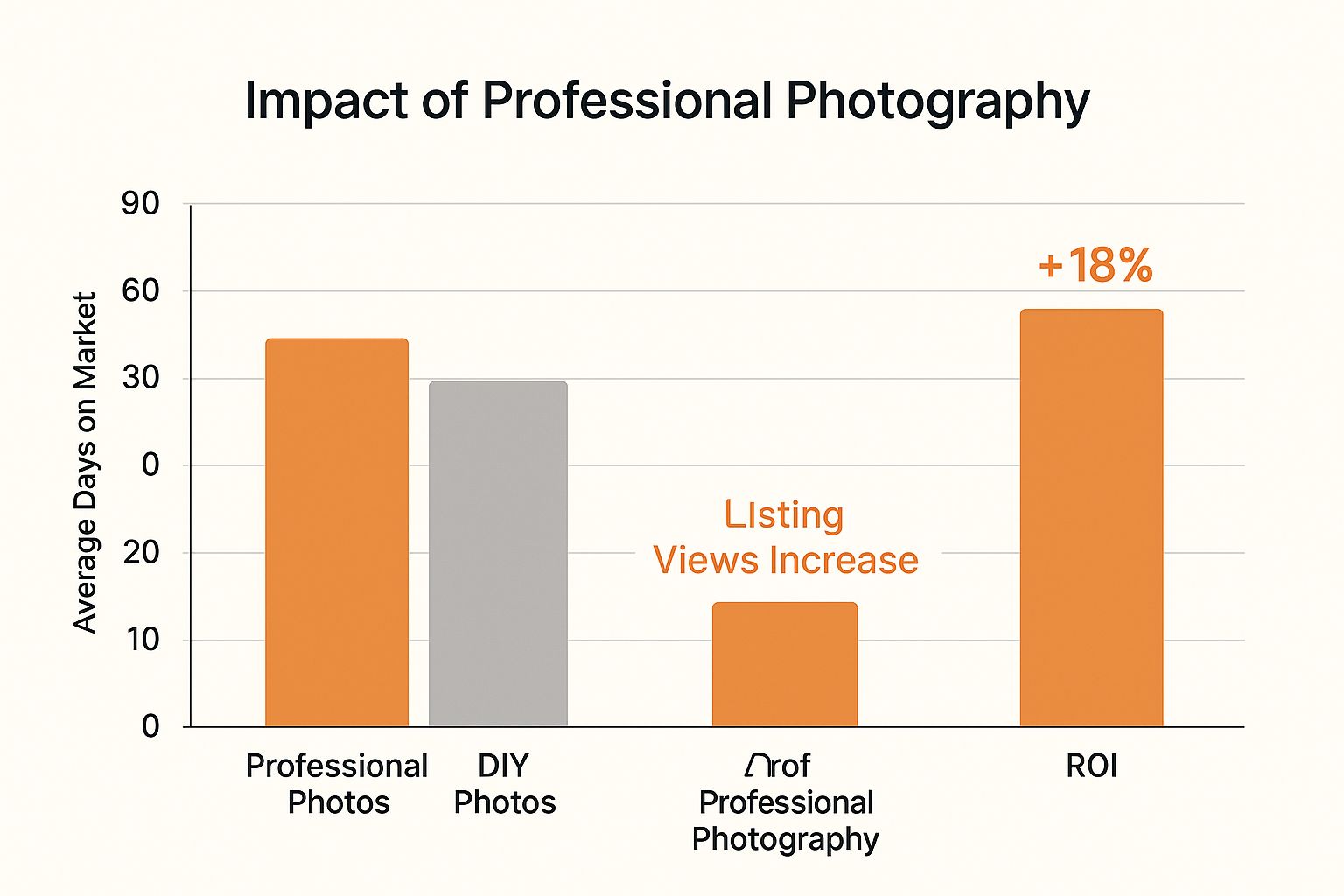
To further illustrate the benefits of professional photography, let's take a look at a table summarizing the impact:
This table compares key performance metrics between listings with professional and amateur photography.
| Performance Metric | Professional Photography | Amateur Photography | Percentage Difference |
|---|---|---|---|
| Listing Views | Significantly Increased (+118%) | Lower | +118% |
| Average Sale Price | Increased (+8%) | Lower | +8% |
| Days on Market | Reduced (89 days) | Higher (123 days) | -28% |
| Likelihood of Sale within Listing Period | 84% Higher | Lower | +84% |
As the infographic and table demonstrate, professional photography significantly reduces time on market, increases listing views by 118%, and boosts the average sale price by 8%. This makes a compelling argument for investing in quality visuals. The National Association of Realtors (NAR) reports that 100% of home buyers start their search online, and 85% consider photos the most important factor when evaluating a property online. Listings with professional photos spend an average of 89days on the market compared to123 days for homes without. Furthermore, homes with professional photography have an 84% higher chance of selling within the listing period. Learn more about the impact of photography in real estate here .
Case Studies and Real-World Examples
Numerous case studies comparing identical properties marketed with different photography styles demonstrate the dramatic impact of professional images. From increased click-through rates to higher final offers, the data consistently reveals that professional photography elevates a property's perceived value and marketability. For instance, a dimly lit, amateur photo of a kitchen might make it appear small and unappealing. A professionally taken image, with proper lighting and composition, can showcase the same kitchen as bright, spacious, and inviting. These details can significantly influence a buyer's decision.
Essential Gear That Won't Break Your Budget
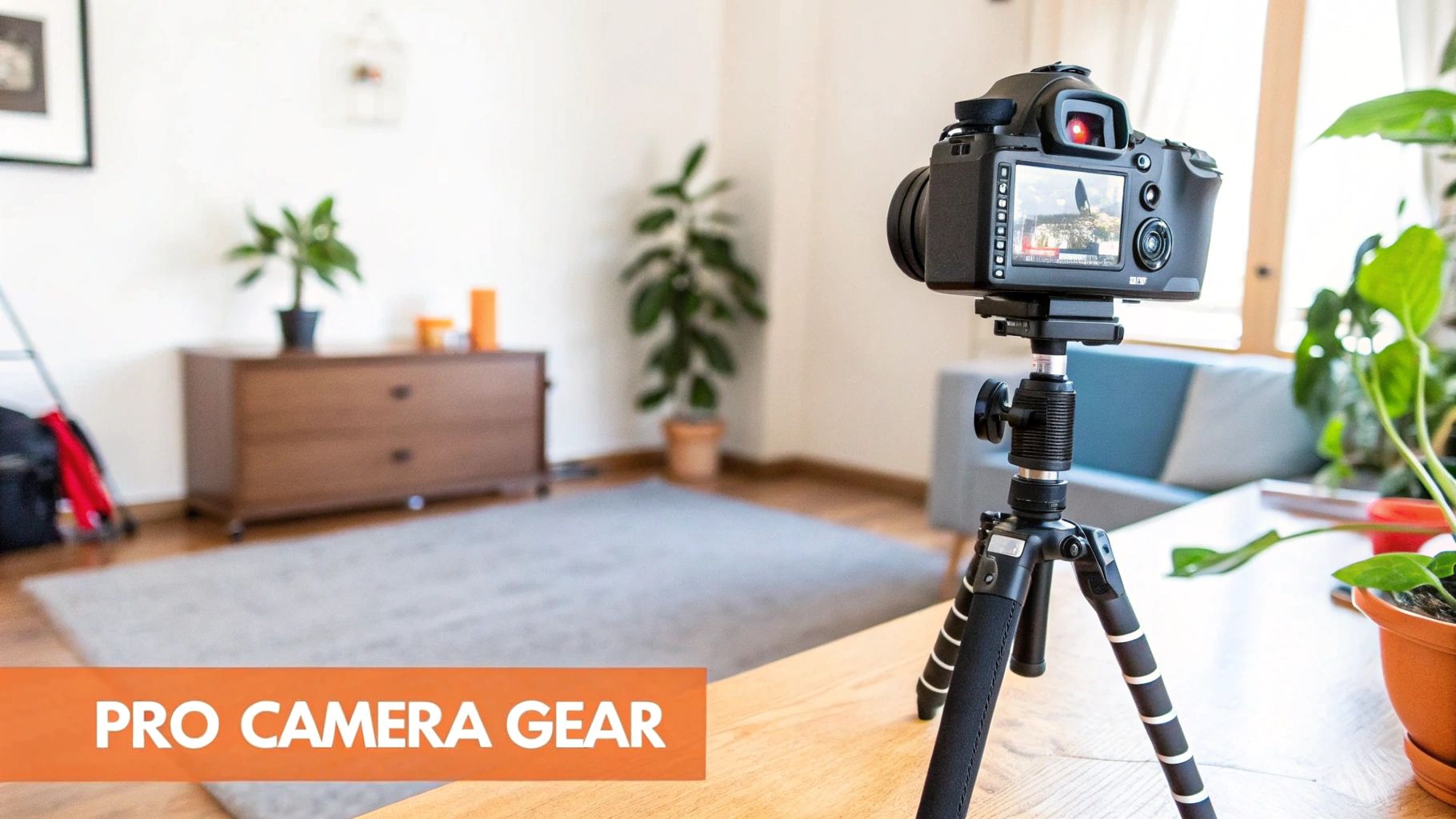
Creating stunning real estate photography doesn't have to be expensive. Let's explore building a budget-friendly kit for professional-quality images. This involves focusing on core equipment and smart investments.
Must-Have Basics
To begin, you'll need a few essential pieces of equipment:
- A Reliable Camera:While afull-frame camera offers top-tier image quality, an APS-Cor evenMicro Four Thirds camera can produce excellent real estate photos. Prioritize features like wide dynamic rangeandstrong low-light performance.
- A Wide-Angle Lens: This lens type is crucial for capturing the full scope of a room. A focal length between 16-35mm (full-frame equivalent) is recommended.
- A Sturdy Tripod: A tripod is essential for sharp images, particularly in low light. It also maintains consistent framing for techniques like HDR blending.
- A Remote Shutter Release: This handy tool minimizes camera shake, further enhancing image sharpness, especially during longer exposures.
Smart Upgrades and Lenses
As your budget and skills develop, consider these upgrades:
- A Flash Unit:Aspeedlight provides greater control over lighting, filling in shadows, especially in tricky interior settings.
- A Second Lens:Aprime lens with a wider aperture (like f/1.8) excels in low light and creates a shallow depth of field to emphasize details.
- A Panorama Head: This specialized tripod head simplifies creating seamless panoramic images, perfect for showcasing large rooms and expansive views.
For more guidance, check out our detailed guide on cameras for real estate photography .
Renting vs. Buying
Some specialized gear, like tilt-shift lenses for architectural photography, can be quite pricey. Renting these for specific projects is often more cost-effective than buying, especially when starting out. This gives you access to professional-level equipment without the hefty upfront cost.
Comparing Entry-Level and Pro-Grade Gear
This table highlights the key differences between entry-level and pro-grade equipment:
| Feature | Entry-Level | Pro-Grade |
|---|---|---|
| Image Quality | Good, suitable for most needs | Excellent, superior low-light performance and dynamic range |
| Durability | Generally less rugged | Built to withstand professional use |
| Features | Basic features | Advanced features for greater control |
| Cost | Budget-friendly | Significant investment |
Choosing the right gear is all about balancing your budget with your specific requirements. By focusing on essential items and strategically upgrading as your business grows, you can produce compelling real estate photography without overspending.
Mastering Light: The Key to Showcase-Worthy Images
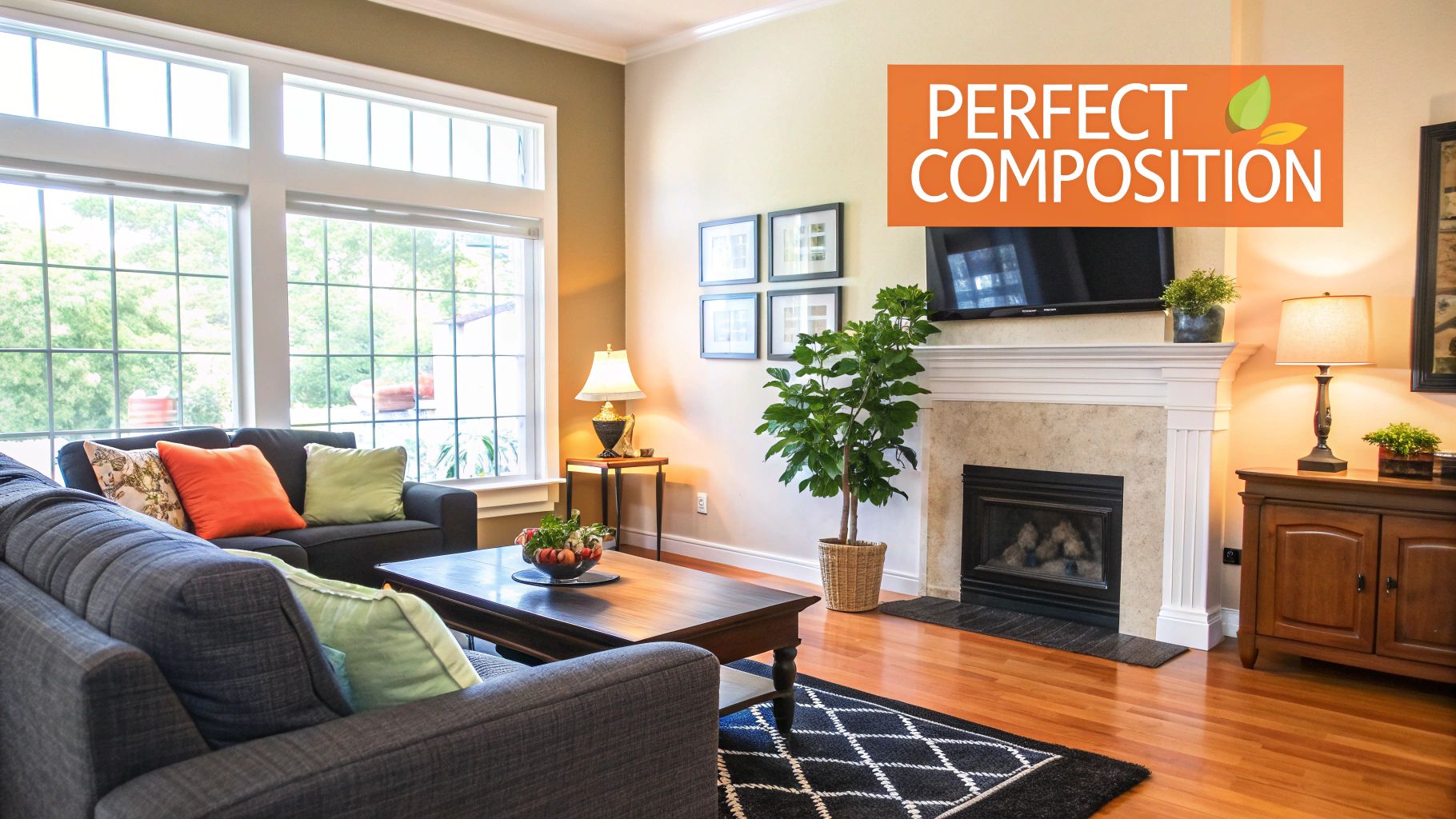
Light plays a vital role in real estate photography. It can transform a simple room into an inviting space. Many photographers find mastering light a challenge. This section will explore professional lighting techniques to help you capture stunning images that resonate with potential buyers.
Scheduling Shoots for Optimal Natural Light
Using natural light effectively is the first step. This involves scheduling your photoshoots strategically. Consider the property's orientation. Morning light works well for east-facing properties, creating a warm ambiance. West-facing properties, however, look best in the soft, golden light of the afternoon.
South-facing properties are typically well-lit throughout the day, with midday sun offering the most brightness. North-facing properties often present a challenge, sometimes requiring extra lighting. Therefore, carefully planning your shoot time and understanding light direction is essential.
Simple Lighting Setups for Common Challenges
Even with the best planning, lighting challenges will arise. Dark interiors may need strategically positioned flashes or off-camera lighting. For aerial perspectives, consider the best drone for professional photography . Drones can offer impressive views and add valuable context to your real estate photos.
Balancing exterior and interior exposures can be tricky. HDR blending helps capture details in both bright and shadowed areas, significantly improving the final image quality.
Room-Specific Lighting Approaches
Different rooms call for different lighting strategies. In kitchens, highlighting under-cabinet lighting can create depth and warmth. Bathrooms often benefit from soft, diffused light for a relaxing, spa-like feel.
Challenging spaces with limited natural light or awkward angles can be transformed with creative solutions. A simple reflector can brighten a dark corner by bouncing light, improving the overall feel of the space.
Enhancing Perceived Value and Appeal
Mastering light goes beyond technical skill; it's about visual storytelling. By understanding how light interacts with a space, you can showcase a property's best features and create images that connect with potential buyers.
Highlighting architectural details or showcasing a cozy fireplace can evoke an emotional response, turning a house into a home in the buyer's imagination. This connection can boost perceived value and help sell the property faster.
Composition Strategies That Highlight Selling Points
Real estate photography isn't just about taking snapshots; it's about crafting a compelling story. Thoughtful composition elevates a property listing, strategically using camera position, height, and angle to create a sense of spaciousness, flow, and desirability. This is where the true artistry comes into play.
Creating Perceived Spaciousness and Flow
Where you position your camera drastically impacts a room's perceived size. A lower angle can make a room feel larger, while a higher vantage point showcases ceiling height and architectural details. Choosing the right lens, typically a wide-angle, helps capture the whole room without distortion.
The flow of a room guides the viewer's eye. Compositional techniques like leading lines, such as a hallway leading to a bright window, draw the viewer in, creating depth and a sense of exploration.
Showcasing Different Architectural Styles and Floor Plans
Different properties call for different approaches. A modern, minimalist home benefits from clean, symmetrical shots emphasizing geometric lines and open space. A cozy cottage, however, shines through warm compositions highlighting charming details and intimate spaces. Understanding a property's unique character is key to effective visual storytelling.
To better understand how to tailor your photography approach to each property type, refer to the table below.
To understand how to best capture different property types, see the table below outlining some best practices. It details how lens choices, angles, and considerations can significantly impact the final image.
| Property Type | Recommended Lenses | Key Shooting Angles | Special Considerations | Common Challenges |
|---|---|---|---|---|
| Modern Apartment | Wide-angle, prime lenses | Low angles for spaciousness, highlighting geometric lines | Minimalist staging, focus on natural light | Capturing the scale of open-plan layouts |
| Cozy Cottage | Prime lenses, macro lens for details | Eye-level angles, capturing intimate spaces | Highlighting textures, warm lighting | Limited space, managing clutter |
| Historic Home | Wide-angle, tilt-shift lens | Angles that emphasize architectural features, grand staircases | Balancing historical accuracy with modern appeal | Uneven lighting, showcasing intricate details |
| Suburban Home | Wide-angle for exteriors, prime lenses for interiors | Variety of angles, showcasing curb appeal and interior flow | Highlighting family-friendly features, landscaping | Capturing the essence of suburban living |
| Commercial Property | Wide-angle, tilt-shift for perspective correction | Angles that maximize space and functionality, showcasing amenities | Clean and uncluttered staging, emphasizing natural light | Balancing detail with overall impression of space |
This table provides a starting point for tailoring your photographic approach to various property types. Remember to consider the unique features of each space and adjust your techniques accordingly.
Emphasizing Best Features and Minimizing Less Appealing Aspects
Real estate photography is all about highlighting strengths. A well-composed shot emphasizes a beautiful fireplace or stunning view while minimizing less desirable aspects. This might involve strategic furniture placement or using lighting to create a focal point. Proper lighting is essential. Consider under cabinet lighting for added impact.
Visual Narratives and Mental Mapping
Professional real estate photographers create visual narratives. They mentally map a property, visualizing how a potential buyer might experience the space. This pre-visualization allows them to capture a sequence of images that guides the viewer through the property naturally and compellingly.
Residential vs. Commercial: Specialized Approaches
Residential photography focuses on creating a warm, inviting atmosphere. Commercial real estate photography emphasizes functionality, size, and potential use. This might involve showcasing amenities, highlighting natural light, or demonstrating foot traffic flow.
Understanding these nuances is crucial for creating effective real estate photography that attracts the right audience and drives successful sales.
Beyond Still Photos: Technologies That Win Listings
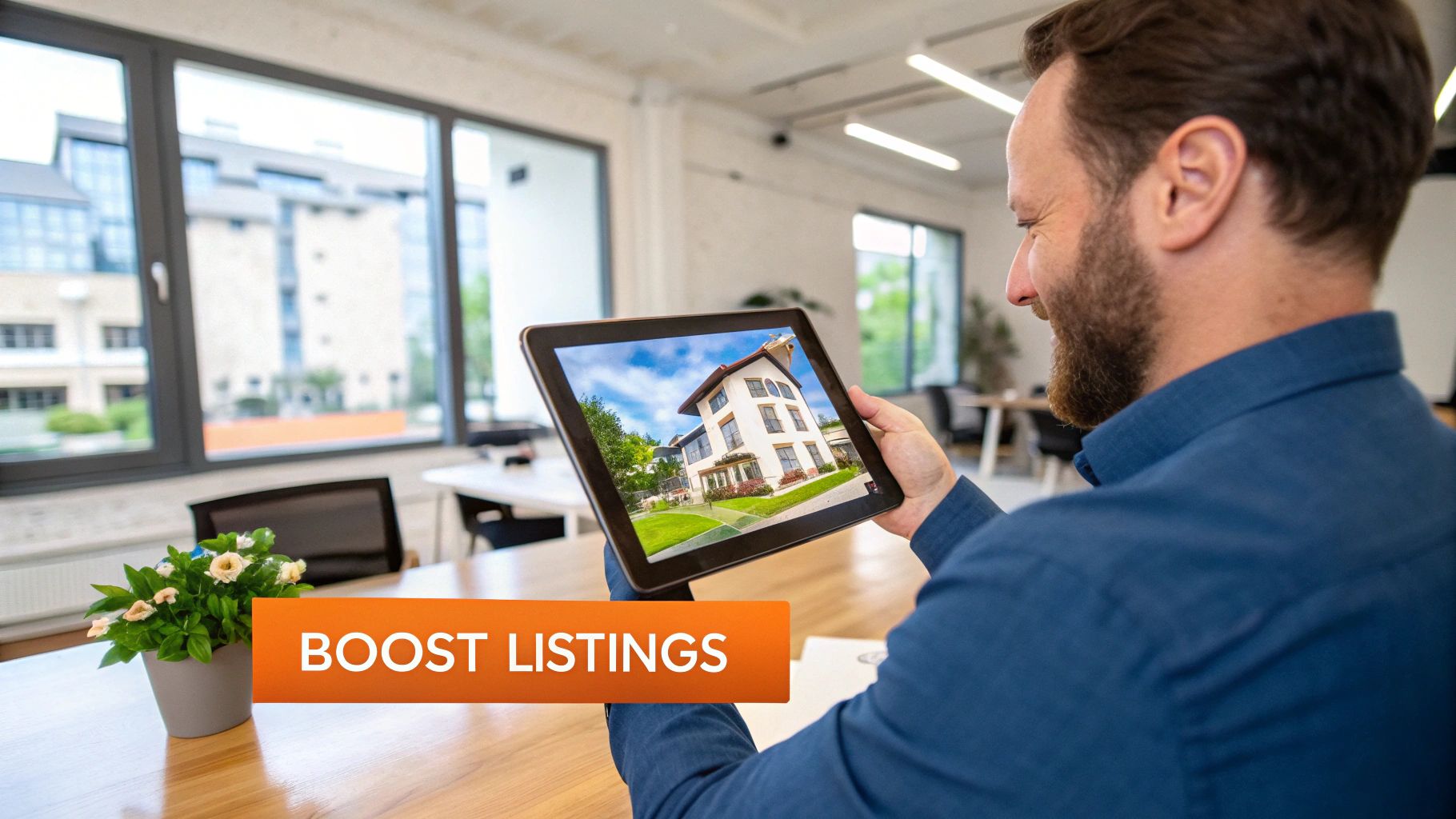
Real estate photography is constantly changing. New technologies give agents exciting new options for showcasing properties and attracting buyers. This section explores those advancements, concentrating on practical uses and their return on investment (ROI).
Aerial Photography: Taking Listings to New Heights
Aerial photography, especially using drones, offers a unique perspective impossible with traditional photography. Drones capture expansive views, showcasing the surrounding area and highlighting key features. Think landscaping, pools, and proximity to desirable amenities. This broad perspective helps potential buyers visualize the property and its location – a critical factor in their decision-making.
For instance, a drone shot can perfectly capture a large backyard, something hard to convey with ground-level photos. They can also highlight nearby parks, schools, or shopping centers, providing valuable context for buyers.
Virtual Tours: Immersive Experiences That Drive Engagement
Virtual tours create immersive experiences, allowing potential buyers to explore a property from anywhere. These 360-degree walkthroughs give buyers a realistic sense of the space, layout, and flow, helping them imagine themselves living there.
This is especially helpful for out-of-town buyers or those with busy schedules, eliminating the need for multiple in-person visits. Virtual tours also increase buyer engagement, leading to more qualified leads. They simply offer a more complete and engaging viewing experience than static images can.
The growth of real estate photography is clear, with advanced visual tools becoming more common. By 2025, 82% of real estate agencies were using drones, and homes with aerial photos sold 68%faster. Around22% of home listings now include virtual tours, offering immersive experiences for potential buyers. Learn more from these real estate photography statistics .
Integrating Technology for Comprehensive Marketing Packages
Smart real estate agents are incorporating these technologies into complete marketing packages. By combining professional photography, aerial shots, and virtual tours, they create dynamic and eye-catching presentations. These packages showcase properties in the best possible way, maximizing their appeal.
The ROI of Emerging Technologies
While these technologies require an upfront investment, the potential ROI is significant. Aerial photography and virtual tours can reduce time on market, boost buyer interest, and ultimately lead to higher sale prices.
These tools allow agents to offer premium marketing services, justifying higher commissions and attracting more listings. Investing in technology isn't just about showcasing properties; it's about building a modern, tech-savvy brand. Agents who embrace innovation and leverage technology will gain a competitive edge and position themselves for greater success.
Editing Workflows That Maintain Authenticity
Post-processing is where good real estate photography becomes great. It's the art of transforming raw images into compelling visuals that tell a property's story. However, there's a fine line between enhancement and misrepresentation. This section explores ethical editing workflows that elevate a property's appeal while maintaining authenticity.
Essential Editing Sequence for Real Estate Images
Professional real estate photographers typically follow a specific editing sequence to ensure consistency and quality. The workflow usually begins with global adjustments, such as correctingwhite balanceandexposure. This establishes the foundation for further edits.
Next, they'll address perspective distortion, a common problem with wide-angle lenses. Correcting vertical and horizontal lines helps rooms appear more natural and balanced. This step is followed by local adjustments, focusing on specific areas within the image, such as brightening shadows or reducing glare.
Finally, color correctionandcontrast adjustments add vibrancy and depth. The aim throughout this process is to enhance, not fabricate, the reality of the property.
Time-Saving Workflows and Consistency
Maintaining consistency across a set of property images is crucial for a professional presentation. Using presets in editing software like Adobe Lightroom can significantly speed up the workflow. Presets help ensure a uniform look and feel across all photos.
Think of a preset as a recipe for editing. It applies a pre-defined set of adjustments, saving time and effort. This ensures a cohesive visual narrative throughout the property's photos.
Correcting Perspective, Balancing Light, and Window Exposures
Wide-angle lenses, while essential for capturing spacious interiors, can distort lines. This can make rooms appear unnatural. Perspective correction tools in editing software help straighten these lines, creating a more accurate depiction. This process is especially important for properties with distinctive architectural features. For a more detailed explanation, check out our guide on real estate photo editing services .
Balancing mixed lighting can be a challenge. This is particularly true when natural light from windows combines with artificial interior lights. Techniques like HDR blending, which combines multiple exposures, help capture detail in all areas. This creates a balanced and natural-looking image.
Window pull, where the view outside is overexposed, is a common issue. Correcting this involves carefully adjusting the window area's exposure. This reveals the outside view without losing interior detail.
Ethical Considerations and Avoiding Misrepresentation
While enhancing images is acceptable, misrepresenting a property is unethical. Removing permanent fixtures, dramatically altering room sizes, or concealing structural flaws is misleading. This can also have legal consequences. The goal of real estate photography is to present a property attractively while maintaining accuracy.
Presenting an accurate depiction builds trust with potential buyers and prevents issues later.
Buyer Engagement and the Impact of Over-Processing
Subtle use of techniques like HDR blending can increase buyer engagement. However, over-processed images often deter buyers. These images are characterized by overly saturated colors, unrealistic HDR effects, and excessive sharpening. They look artificial and can raise doubts about the property's actual condition.
A nuanced approach to editing is essential. The goal is to enhance the image, not create a fantasy.
Acceptable Improvement vs. Misleading Manipulation: Defining the
Boundaries
Understanding the difference between acceptable enhancement and misleading manipulation is crucial for ethical real estate photography. Adjusting brightness, contrast, and color saturation to create a more appealing image is generally acceptable.
However, digitally adding non-existent features, removing permanent fixtures, or drastically changing the property's appearance is unethical. It's also potentially misleading. By adhering to ethical editing practices, photographers build trust and contribute to a transparent real estate market. This involves a commitment to accuracy and a focus on enhancing reality, not fabricating it.
Looking for a simpler way to enhance real estate photos? Pedra , an AI-powered software, offers a range of tools for virtual staging, realistic renders, and photo enhancements – all with a single click.
- Canon TS-E 24mm f/3.5L II Tilt-Shift Lens
For real estate photography, controlling perspective is crucial. The Canon TS-E 24mm f/3.5L II Tilt-Shift lens is a premium piece of real estate photography equipment specifically designed to address this need. Say goodbye to distorted images where walls appear to lean inwards – a common problem with standard wide-angle lenses. This lens allows you to correct converging vertical lines, ensuring professional-looking, straight-walled interiors and exteriors. This makes it a worthwhile investment for realtors, real estate companies, home staging businesses, and real estate marketing professionals looking to elevate their property listings.
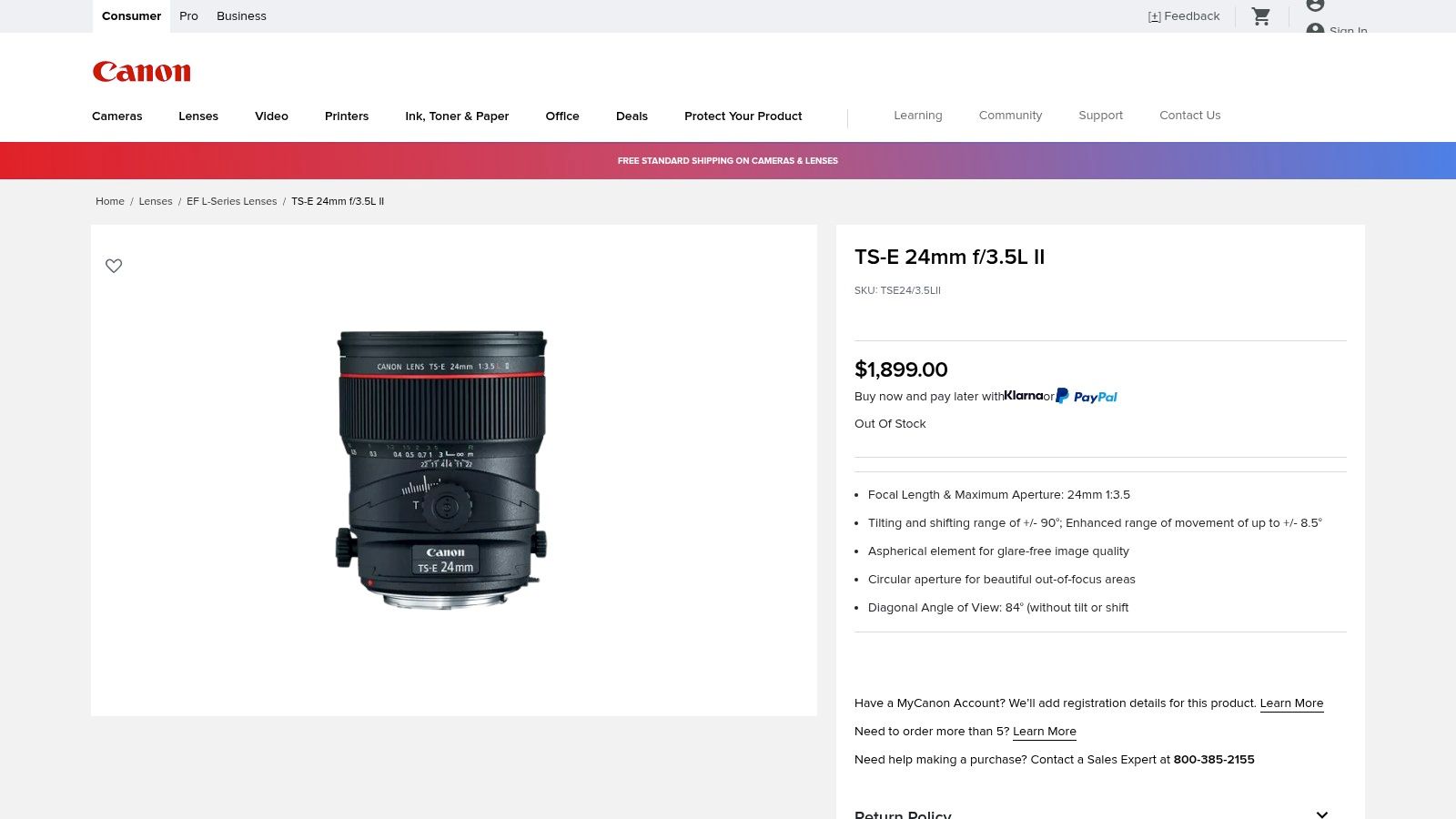
The 24mm focal length is ideal for capturing spacious interiors, offering a wide field of view without excessive distortion. Its tilt-shift mechanism gives you precise control over perspective, with ±8.5° tilt and ±12mm shift adjustments. While other wide-angle lenses might capture more of a room, they often introduce unwanted distortion. The Canon TS-E 24mm f/3.5L II combats this, allowing you to showcase a property accurately and attractively. Imagine capturing a stunning kitchen with perfectly straight cabinets and countertops, or a high-rise building standing tall without the converging lines – this lens makes it possible.
The manual focus design, combined with ultra-low dispersion glass elements, guarantees exceptional image quality and sharpness. This level of control and clarity sets this lens apart in the realm of real estate photography equipment. While it has a steeper learning curve compared to standard autofocus lenses, the results speak for themselves. It's a tool for serious real estate photographers who understand the impact of high-quality visuals on property sales.
While the Canon TS-E 24mm f/3.5L II carries a premium price tag (MSRP $1,899) and requires manual focus operation, its ability to correct perspective distortion and deliver exceptional image quality makes it a valuable investment for real estate professionals. Its weather-sealed construction adds to its durability and longevity, protecting your investment.
Pros
- Superior perspective control eliminates converging vertical lines
- Exceptional image quality and sharpness
- Minimal distortion compared to standard wide-angle lenses
- Allows for creative focusing effects
- Weather-sealed construction
Cons
- Very expensive ($1,899 MSRP)
- Steeper learning curve than standard lenses
- Manual focus only
- Large and heavy construction
Implementation Tip
Practice using the tilt-shift movements on different scenes before your first real estate shoot. Mastering the manual focus and understanding the effect of tilt and shift will allow you to capture truly stunning images.
Canon TS-E 24mm f/3.5L II Product Page
- Manfrotto MT055XPRO3 Aluminum Tripod
Investing in the right real estate photography equipment can significantly elevate your listings and attract more potential buyers. A crucial piece of this equipment is a sturdy tripod, and the Manfrotto MT055XPRO3 Aluminum Tripod stands out as a professional-grade option designed for the demands of real estate photography. This tripod offers the stability and versatility you need to capture those perfect, sharp images that truly showcase a property.
This tripod earns its place on this list due to its robust construction, flexible positioning options, and ability to support heavier camera setups. While there are cheaper alternatives, the MT055XPRO3 prioritizes stability and durability, which are essential for consistent, high-quality real estate photography. It's an investment that will pay off in the long run with crisp, professional photos.
One of the standout features of the MT055XPRO3 is its innovative 90-degree center column mechanism. This allows you to quickly switch from vertical to horizontal positioning, opening up creative framing possibilities, especially useful for capturing wide interior shots or detailed architectural features. Imagine easily switching to a bird's-eye view for showcasing a kitchen island or capturing a sweeping panorama of a living room – this tripod makes it effortless. The Quick Power Lock system allows for rapid leg adjustments, saving you valuable time on location. Whether you're shooting in a cramped condo or a sprawling estate, you can quickly adapt to the environment and frame your shots perfectly.
The MT055XPRO3 boasts a maximum height of 66.9" and a load capacity of 19.8 lbs, making it suitable for even the heaviest DSLR or mirrorless camera setups with professional lenses. This stability is crucial for sharp images, especially in challenging lighting conditions where longer exposures might be necessary. Built-in bubble levels ensure precise alignment, eliminating crooked horizons and ensuring your images look professional.
Pros
- Rock-solid stability: Capture tack-sharp images even with long exposures, vital for low-light interiors.
- Versatile positioning: The 90-degree center column allows for creative angles and perspectives, perfect for showcasing unique architectural details or capturing expansive room shots.
- Durable construction: Built to withstand the rigors of professional use, ensuring long-term reliability.
- Easy setup and adjustment: The Quick Power Lock system makes it quick and easy to adjust the tripod's height and leg angles, saving you time on location.
Cons
- Weight: At 5.5 lbs, it's heavier than carbon fiber options, which might be a consideration for real estate agents frequently traveling between properties.
- Bulk: Can be bulky when fully extended, potentially making it less convenient for tight spaces.
- Price: At $249.99, it represents a higher investment compared to entry-level tripods.
- Head not included: Requires a separate head purchase, adding to the overall cost.
Implementation Tip
When setting up the MT055XPRO3, take advantage of the adjustable leg angles to achieve maximum stability on uneven terrain. Don't forget to utilize the bubble level to ensure your camera is perfectly aligned for straight horizons.
For real estate professionals aiming to capture high-quality images that truly impress potential buyers, the Manfrotto MT055XPRO3 Aluminum Tripod is a worthwhile investment. While it comes at a premium price, its stability, versatility, and durability make it a valuable addition to your real estate photography equipment arsenal.
Manfrotto MT055XPRO3 Aluminum Tripod
- Godox AD200Pro Flash
The Godox AD200Pro Flash is a game-changer for real estate photography equipment setups, offering a powerful and portable lighting solution that elevates interior shots from average to stunning. This flash system delivers a robust 200Ws of power, more than enough to illuminate large rooms and combat challenging lighting situations often encountered in real estate photography. While a basic speedlight might struggle in a spacious living room, the AD200Pro provides ample power to fill the space with beautiful, even light. This extra power also allows you to use modifiers like softboxes and umbrellas effectively, creating a more professional and polished look.
One of the standout features is its interchangeable flash head system. You can quickly switch between a standard speedlight head for directional light and a bare bulb head for a broader, more omnidirectional spread. This versatility makes the AD200Pro adaptable to various real estate photography scenarios. Need to highlight architectural details in a hallway? Use the speedlight head. Want to create a soft, ambient glow in a bedroom? Switch to the bare bulb. This adaptability is invaluable for real estate agents, home stagers, and real estate marketing companies looking to showcase properties in their best light.
Beyond its power and versatility, the AD200Pro shines with its portability. Being battery-powered, you can easily move it around a property without being tethered to a power outlet. This is a huge advantage for real estate photographers who need to be nimble and efficient on location. The built-in 2.4GHz wireless X system offers a reliable 328' range, giving you the freedom to position the flash precisely where you need it. The fast recycle time of 0.01-2.1 seconds ensures you won't miss crucial shots, especially during fast-paced shoots. For those working with tight deadlines, this speed and efficiency are crucial.
While the Godox AD200Pro is a powerful tool, there is a slight learning curve involved in mastering optimal flash placement and power settings. It also requires additional triggers for camera synchronization, adding to the overall cost. Priced around $349, it is a more significant investment compared to basic speedlights. Furthermore, battery life can diminish with frequent full-power usage, so carrying spare batteries is recommended. However, for serious real estate photographers, the benefits of the AD200Pro far outweigh the drawbacks. Learn more about Godox AD200Pro Flash
Key Features and Benefits
- 200Ws Power Output: Illuminates large interiors effectively.
- Interchangeable Heads: Offers versatile lighting options with speedlight and bare bulb heads.
- Portable and Battery-Powered: Enables freedom of movement on location.
- Wireless Control: Provides convenient and flexible flash placement.
- TTL and Manual Modes: Caters to various shooting styles and skill levels.
Pros
- Powerful enough to light large rooms
- Portable and battery-powered
- Versatile with interchangeable heads
- Compatible with various triggering systems
Cons
- Requires additional triggers
- Learning curve for optimal use
- More expensive than basic speedlights ($349)
- Battery life diminishes with heavy use
Website: https://www.godox.com/products/ad200pro/
This powerful and portable flash system is a worthwhile investment for anyone serious about elevating their real estate photography equipment and producing high-quality images. It earns its place on this list due to its power, versatility, and portability, making it a valuable tool for real estate professionals. By utilizing the Godox AD200Pro, realtors, real estate companies, and home staging businesses can significantly enhance the visual appeal of their property listings, capturing the attention of potential buyers and ultimately driving sales.
7. DJI Mavic 3 Drone
Elevate your real estate photography with the DJI Mavic 3 drone, a professional-grade tool that captures breathtaking aerial perspectives of properties. This drone revolutionizes real estate marketing by providing stunning visuals that stand out. Its Hasselblad camera system, known for its exceptional image quality, ensures your property listings are presented in the best possible light. The Mavic 3's advanced features, such as obstacle sensing and extended flight time, allow you to capture comprehensive aerial coverage of properties and their surrounding landscapes. This makes it an invaluable piece of real estate photography equipment for showcasing everything from sprawling estates to cozy suburban homes.
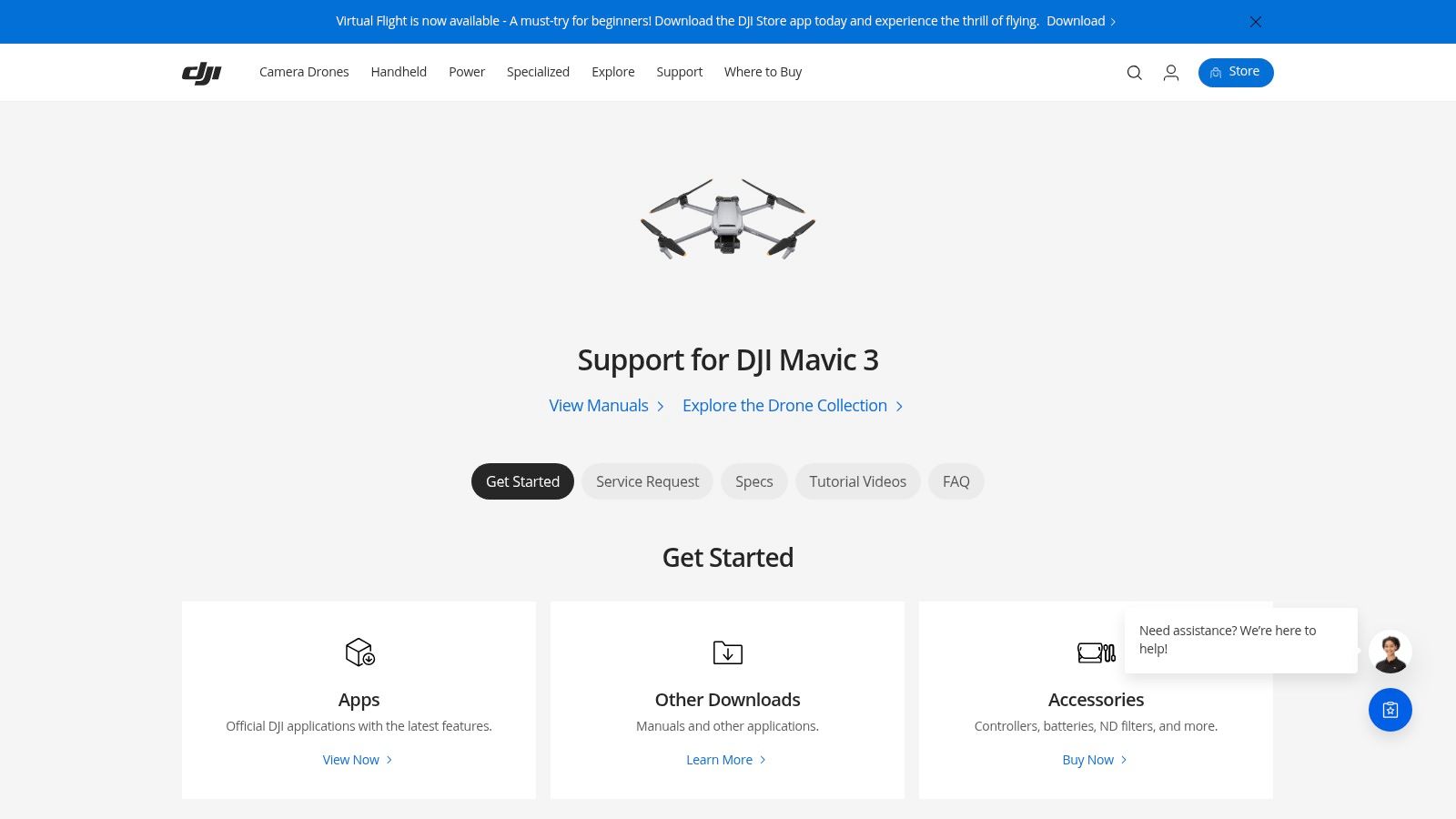
Real estate agents, realtors, and real estate companies can leverage the Mavic 3 to create compelling marketing materials. Capture sweeping views of the property, highlight its location within the neighborhood, and showcase nearby amenities like parks and schools. For home staging and real estate marketing companies, the Mavic 3 offers a unique perspective to potential buyers, making properties more attractive and memorable. Imagine showcasing a beachfront property with a dramatic flyover shot or highlighting the expansive acreage of a rural estate. These dynamic visuals provide a comprehensive understanding of the property's layout and surroundings, impossible to achieve with traditional ground-level photography.
The Mavic 3 boasts a Hasselblad 4/3 CMOS sensor with 20MP resolution, providing crisp, high-quality images. The adjustable aperture, ranging from f/2.8 to f/11, allows for creative control over depth of field. With a maximum flight time of 46 minutes, you can cover large properties without needing to swap batteries mid-flight. The omnidirectional obstacle sensing ensures safe operation, particularly valuable when flying near buildings. Furthermore, the 10-bit D-Log color profile provides enhanced flexibility for post-processing, allowing you to achieve professional-grade color grading.
While the DJI Mavic 3 represents a significant investment (starting at $2,049 for the standard package), its capabilities justify the price for serious real estate professionals. It's important to be aware of legal requirements like FAA registration and potentially Part 107 certification. Weather conditions can also limit shooting opportunities. While the drone is designed for ease of use, there is a learning curve for mastering smooth flight control and composition. For realtors looking to create interactive property experiences, learn more about DJI Mavic 3 Drone and how aerial footage can be integrated.
Pros
- Superior image quality with Hasselblad camera system
- Extended flight time covers large properties
- Compact folding design for easy transport
- Advanced safety features reduce crash risk
Cons
- Significant investment
- Requires FAA registration and potentially Part 107 certification
- Weather restrictions
- Learning curve for flight control and composition
Website: https://www.dji.com/mavic-3
- Adobe Lightroom Classic
While not a physical piece of real estate photography equipment, Adobe Lightroom Classic is an indispensable software tool for any serious real estate photographer. It's the industry standard for organizing, editing, and enhancing property images, allowing you to manage large photo libraries and perform crucial adjustments to make your listings shine. Think of it as your digital darkroom, where you transform RAW files into stunning, market-ready photographs. This software is essential for real estate photography equipment workflows.
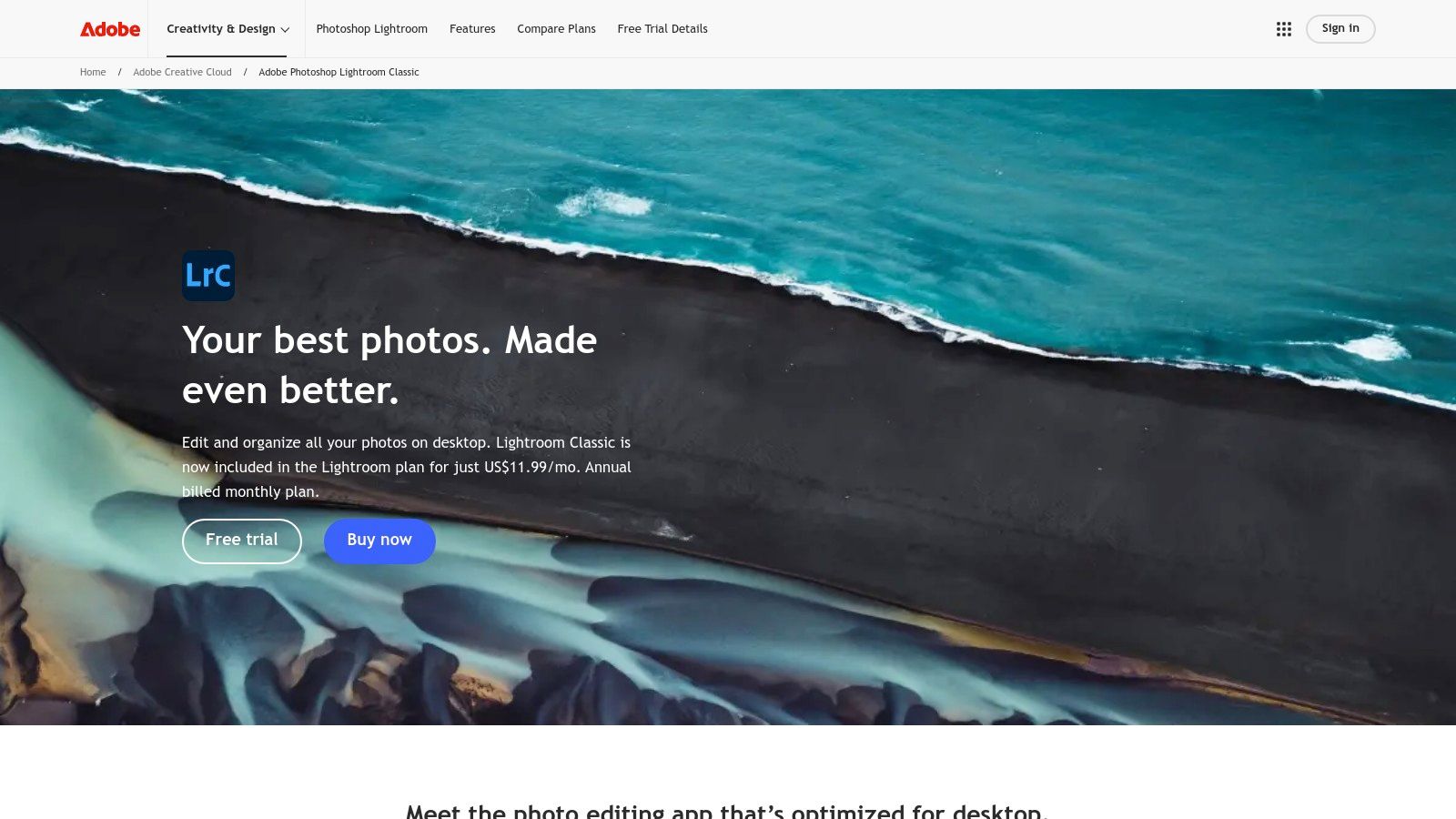
Lightroom Classic's comprehensive toolset is specifically valuable for the demands of real estate photography. You can correct perspective distortions common in architectural photography, balance exposures for interiors with mixed lighting, and enhance colors to make rooms feel inviting. The software's batch processing capabilities ensure a consistent look across an entire property shoot, saving you valuable time and effort. This consistency is crucial for presenting a professional and cohesive image of a property to potential buyers. Realtors, real estate companies, and home staging businesses all benefit from the polished, professional results achievable with Lightroom.
For real estate agents and realtors, efficiently managing visuals is critical. Lightroom Classic's catalog system allows you to organize photos from multiple properties, making it easy to find and edit images for specific listings. Imagine seamlessly transitioning from editing photos of a modern condo to a sprawling ranch house, all within a well-structured catalog. This level of organization streamlines your workflow, enabling faster turnaround times and increased productivity.
Features
- Advanced RAW photo processing capabilities
- Perspective correction and lens distortion removal tools
- Catalog system for organizing multiple property shoots
- Batch processing for consistent editing across property images
- Seamless integration with Photoshop for advanced editing
Pros
- Comprehensive toolset specifically designed for real estate editing
- Non-destructive editing preserves original files
- Efficient workflow with presets and batch processing
- Industry standard with extensive learning resources available
Cons
- Subscription-based pricing ($9.99/month with Adobe's Photography Plan)
- Can be resource-intensive on older computers
- Steeper learning curve for beginners
- Requires regular catalog maintenance for optimal performance
Implementation/Setup Tips
- Create a structured catalog system: Organize your photos by property address or client name to maintain a clear and efficient workflow.
- Develop Presets: Save your preferred editing settings as presets to quickly apply consistent edits across multiple images.
- Utilize Batch Processing: Edit a single image and then apply those edits to a whole set of photos from the same shoot, ensuring a cohesive look.
- Explore Tutorials: Numerous online resources are available to help you master Lightroom Classic's features, from basic adjustments to advanced techniques.
Website: https://www.adobe.com/products/photoshop-lightroom-classic.html
Lightroom Classic is more than just software; it's an investment in your real estate photography business. It's the key to unlocking the full potential of your images, transforming them into powerful marketing tools that attract buyers and close deals. While the subscription cost and learning curve might seem daunting initially, the long-term benefits in terms of efficiency, quality, and professional presentation make it a worthwhile addition to your real estate photography equipment arsenal.
8-Item Real Estate Photography Gear Comparison
| Product | Core Features & Capabilities | User Experience & Quality ★★★★☆ | Value & Pricing 💰 | Target Audience 👥 | Unique Selling Points ✨ |
|---|---|---|---|---|---|
| 🏆 Pedra | AI virtual staging, renders, video tours, floor plans | Intuitive, no technical skill needed, 5★ rating | Flexible subscription €29/mo, 100 images | Real estate agents, agencies | One-click AI, all-in-one platform, pro editing services |
| Canon EOS 5D Mark IV | 30.4MP full-frame DSLR, 4K video, 61-point AF | Exceptional image quality, weather-sealed | ~$2,500 body only | Professional real estate photographers | High dynamic range, reliable autofocus |
| Sony Alpha a7 III | 24.2MP mirrorless, 5-axis IBIS, 693-point AF, 4K HDR video | Compact, excellent low-light, long battery life | ~$1,998 body only | Advanced photographers, pros | Lightweight, superior low-light, mirrorless benefits |
| Canon TS-E 24mm f/3.5L II Lens | Tilt-shift 24mm, perspective control, ultra-sharp optics | Exceptional sharpness, manual focus | ~$1,899 MSRP | Architecture & real estate pros | Corrects perspective distortion, minimal image distortion |
| Manfrotto MT055XPRO3 Tripod | 66.9" max height, 19.8 lbs load, horizontal center column | Stable, durable, versatile | ~$250 | Real estate photographers | Horizontal center column, quick leg locks |
| Godox AD200Pro Flash | 200Ws, interchangeable heads, wireless, TTL/manual modes | Portable, versatile flash power | ~$349 | Real estate photographers | Portable with strong lighting, interchangeable heads |
| DJI Mavic 3 Drone | Hasselblad 20MP, 46 min flight, obstacle sensing | Superior aerial quality, compact | ~$2,049 | Real estate marketers, photographers | Pro aerial shots, long flight, advanced safety features |
| Adobe Lightroom Classic | RAW editing, perspective correction, batch processing | Industry standard, non-destructive edits | $9.99/mo (Photography Plan) | Photographers, editors | Powerful editing, catalog organization |
Ready to Capture Stunning Real Estate Photography?
From cameras like the Canon EOS 5D Mark IV and Sony Alpha a7 III to specialized equipment like the Canon TS-E 24mm tilt-shift lens and the versatile DJI Mavic 3 drone, the right real estate photography equipment can transform your listings. Coupled with essential tools like the Manfrotto tripod and Godox flash, and enhanced by software like Adobe Lightroom Classic, these tools empower you to create truly captivating visuals. Remember, choosing the best real estate photography equipment depends on your specific needs and budget. Consider factors like image quality, portability, and ease of use when making your selections. Just as a thoughtful security screen investment can enhance your property's value and safety, according to XL Security and Blinds' article Are Crimsafe Screens Worth It?, investing in quality photography equipment significantly elevates your marketing materials and attracts potential buyers.
The most important takeaway? High-quality visuals are crucial for success in today's competitive real estate market. By mastering the use of these powerful tools, you'll not only showcase properties in their best light but also establish yourself as a professional committed to excellence.
Want to take your real estate photography to the next level? Explore Pedra, an innovative AI tool designed to streamline your workflow and enhance your images. Pedra helps you perfect your photos quickly and easily, saving you valuable time and effort in post-production.

Related Posts
Top 7 AI Room Decoration Tools for 2025
Discover the best AI room decoration software for 2025. Our review compares top tools to help you de...
9 Curb Appeal Ideas on a Budget That Actually Work (2025)
Transform your home's exterior with our top curb appeal ideas on a budget. Get easy, high-impact tip...
10 Essential Curb Appeal Improvements for 2025
Discover 10 essential curb appeal improvements to boost property value. This guide for real estate p...